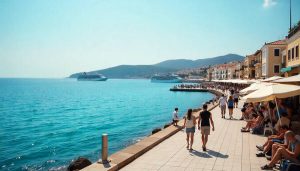Sunday, July 20, 2025
The world’s best known destinations are witnessing an unimaginable tourist tsunami as a surge of international travel plates up in record proportions. Venice, Barcelona, Paris; Spain, France and Italy are struggling to come to terms with an assault of visitors that has exceeded pre-pandemic levels. From overcrowded streets in Spain’s coastal towns to a record number of tourists in Paris, these destinations are facing the quandary of how to sustain the economic advantages that tourism brings without the burden it puts on local infrastructure, resources and inhabitants. In recent weeks, deep into 2025, the impact of a surging tide of tourists is remaking travel habits, as well as the rules for governments and locals trying to find ways to cope with it.
International travel had recovered to 99% of pre-pandemic levels by 2024, and global arrivals continued to increase in early 2025. The United Nations World Tourism Organization (UNWTO) reported that international tourist arrivals from January to March of 2025 were 5% higher than for the same period in 2024 and 3% higher than in the first quarter of 2019. This spike is due largely to the phenomenon of “revenge travel,” with people taking vacation trips they delayed for a long time. The economic benefits of this takeoff may be clear, but the ramifications for the world’s most popular tourist destinations are not.
Advertisement
Advertisement
From Venice, to Barcelona, to Paris, to Spain, the world’s top tourist destinations’ reaction to tourism pressures shaped up in 2025. From new regulations in Venice to protests in Barcelona, we’ll look at how these iconic locales are dealing with the challenges and what it means for the future of travel.
The Global Tourism Boom: A Trend That Shows No Signs of Slowing Down
2025 marks a significant milestone in the recovery of global tourism, as international arrivals surge beyond expectations. According to the UNWTO, global tourism was already near pre-pandemic levels in 2024, and the first quarter of 2025 saw a further 5% increase in arrivals compared to 2024. This is a clear sign that revenge travel, a term used to describe the surge of trips postponed during the pandemic, is still in full swing. As travelers continue to make up for lost time, destinations that were once inundated with tourists are now grappling with the overwhelming demand.
Europe has seen a particularly noticeable impact, with countries like France, Spain, and Italy at the forefront of this tourism surge. In France, international tourism reached a record 100 million visitors in 2024, outpacing even pre-pandemic figures. Similarly, Spain welcomed 94 million international tourists in 2024, doubling its population and generating a staggering €126 billion in revenue. This flood of visitors has put immense pressure on key cities and tourist hotspots, particularly those that were already struggling with the delicate balance of managing both local and international visitors.
Venice: A City Under Siege by Tourism
Venice, one of the most visited cities in the world, is facing a growing crisis as it tries to manage an overwhelming number of tourists. In 2025, the city’s population has shrunk to less than 50,000, yet it continues to see millions of visitors each year. In 2024, almost 19 million tourists passed through Venice’s airport, further straining its already fragile infrastructure.
To combat this, Venice has introduced a controversial €5 fee for day-trippers, effective during the city’s busiest tourist season from April to July. This entry fee, aimed at reducing the number of short-term visitors and easing the burden on local residents, is part of a larger initiative to manage the impact of tourism. However, the fee has faced criticism from both locals and tourists, with many arguing that it will not effectively address the root causes of overtourism. Despite these challenges, Venice’s move to introduce the entry fee represents one of the most proactive steps taken by a major tourist destination to regulate tourism.
Iconic Tourist Spots in Venice
- St. Mark’s Basilica: One of Venice’s most iconic landmarks, St. Mark’s Basilica features stunning Byzantine architecture and intricate mosaics, making it a must-visit for any traveler.
- The Grand Canal: The city’s main waterway, lined with historic buildings and famous for its gondola rides, provides breathtaking views of Venice’s vibrant culture and history.
- Doge’s Palace: A masterpiece of Gothic architecture, this historic palace was once the residence of the Doge of Venice and now serves as a museum showcasing the city’s political history.
- Rialto Bridge: The oldest of the four bridges spanning the Grand Canal, the Rialto Bridge is an iconic structure offering picturesque views and shopping opportunities.
- Murano Island: Known worldwide for its glassmaking tradition, Murano Island is a tranquil escape offering a unique glimpse into Venetian craftsmanship.
Barcelona: The Price of Popularity
Barcelona, Spain’s second-largest city, is another destination feeling the weight of increased tourism. In 2024, the city welcomed 15.5 million tourists, a stark contrast to its population of just 1.7 million. This imbalance has led to overcrowded streets, higher living costs, and tensions between locals and visitors.
The situation has sparked protests, with some residents taking to the streets to voice their frustration. In some cases, these protests have taken the form of symbolic acts, such as locals spraying tourists with water guns to draw attention to the issue. While these acts are largely non-violent, they highlight the growing resentment towards mass tourism and the pressure it places on the city’s resources. In response, local authorities are exploring ways to regulate short-term rental platforms like Airbnb, which are exacerbating the housing crisis in many popular neighborhoods.
Iconic Tourist Spots in Barcelona
- La Sagrada Família: This world-renowned basilica, designed by Antoni Gaudí, is a masterpiece of modernist architecture that continues to captivate visitors with its awe-inspiring facades and towering spires.
- Park Güell: Another of Gaudí’s creations, this public park offers unique architectural features, colorful mosaics, and panoramic views of Barcelona.
- Casa Batlló: A stunning building on the Passeig de Gràcia, Casa Batlló is another example of Gaudí’s imaginative approach to architecture, known for its surreal design and intricate detailing.
- Barceloneta Beach: A popular destination for both locals and tourists, Barceloneta Beach offers a vibrant atmosphere where visitors can relax by the sea and enjoy fresh seafood.
- Gothic Quarter: A maze of narrow streets and medieval buildings, the Gothic Quarter is home to historic landmarks, quaint shops, and charming cafes, offering a glimpse into the city’s past.
Paris: Striking Back Against Overtourism
Paris, one of the most visited cities in the world, is also grappling with the challenges of overtourism. In 2024, the French capital attracted over 100 million international visitors, outnumbering the local population of 66 million. The Louvre, the world’s most visited museum, capped its daily visitors at 30,000 in an attempt to manage crowds. Despite these measures, the sheer volume of tourists continues to overwhelm the city’s attractions.
In June 2025, staff at the Louvre went on strike, citing overcrowding, lack of staffing, and poor working conditions. The strike forced the museum to close for several hours, leaving thousands of tourists stranded outside. This incident underscores the growing tension between the tourism industry and those who are tasked with maintaining these cultural landmarks. As Paris prepares for the 2024 Olympics, further strains on the city’s infrastructure are expected, making it clear that long-term solutions will be necessary to manage tourism sustainably.
Iconic Tourist Spots in France
- Eiffel Tower: An enduring symbol of Paris, the Eiffel Tower offers breathtaking views of the city from its observation decks, making it one of the most photographed landmarks in the world.
- The Louvre Museum: Home to thousands of works of art, including the Mona Lisa, the Louvre is the world’s most visited museum and a cultural treasure trove.
- Notre-Dame Cathedral: A Gothic masterpiece, Notre-Dame remains one of Paris’s most iconic religious sites, attracting visitors with its stunning architecture and rich history.
- Champs-Élysées: One of the most famous avenues in the world, the Champs-Élysées is lined with theaters, cafés, and luxury shops, leading up to the Arc de Triomphe.
- Montmartre: Known for its artistic history and the stunning Sacré-Cœur Basilica, Montmartre offers a bohemian atmosphere and panoramic views of Paris.
Spain: A Nation on the Brink of Tourism Fatigue
Spain, with its beautiful beaches, historic cities, and rich culture, has long been a favorite among tourists. However, in 2024, the country welcomed 94 million international visitors, a record number that put immense pressure on its infrastructure. Popular coastal destinations, such as Mallorca, the Canary Islands, and Costa Brava, have seen hotel prices rise by 23% over the past three years, as foreign tourism increased by nearly 2 million people.
As a result, domestic tourism has shifted inland, with many Spaniards opting for more affordable vacation destinations away from the crowded coastlines. This shift highlights the growing divide between local residents and foreign visitors, and the need for Spain to find a more balanced approach to managing tourism. The Spanish government is now looking at ways to regulate short-term vacation rentals and impose stricter rules on Airbnb to prevent further strain on the housing market.
Italy: Finding Balance Amid the Chaos
Italy, with its rich history, stunning landscapes, and vibrant culture, has long been a major draw for travelers. However, in 2025, the country is feeling the strain of a booming tourism industry. Venice, Rome, Florence, and the Amalfi Coast are among the most popular destinations, with millions flocking to these locations every year. While tourism is a vital part of Italy’s economy, it also brings significant challenges. The government has introduced various measures, such as the €5 entry fee in Venice, to mitigate the effects of overtourism. These steps are seen as necessary to ensure that Italy’s cultural heritage and local communities are not overshadowed by the demands of tourism.
Conclusion: A New Era of Travel Management
As tourism continues to surge in 2025, destinations like Venice, Barcelona, Paris, Spain, France, and Italy must find innovative ways to balance the economic benefits of tourism with the well-being of local communities and the preservation of their cultural heritage. While new regulations and fees may help curb some of the negative impacts of overtourism, long-term sustainability will require a more comprehensive approach, including better distribution of tourists across regions, investments in infrastructure, and stronger regulation of short-term rentals.
In the coming years, the travel industry will need to rethink the way it approaches mass tourism to ensure that these iconic destinations remain accessible and enjoyable for both locals and visitors alike.
Advertisement
Tags: Barcelona, europe tourism news, france, Italy, Paris, Paris tourism News, rome, spain, Spain Tourism News, Travel, Venice
Advertisement
Tags: Barcelona, europe tourism news, france, Italy, Paris, Paris tourism News, rome, spain, Spain Tourism News, Travel, Venice
I want to receive travel news and trade event update from Travel And Tour World. I have read Travel And Tour World’sPrivacy Notice.
Sunday, July 20, 2025
Sunday, July 20, 2025
Sunday, July 20, 2025
Sunday, July 20, 2025
Sunday, July 20, 2025
Sunday, July 20, 2025
Sunday, July 20, 2025
Sunday, July 20, 2025




